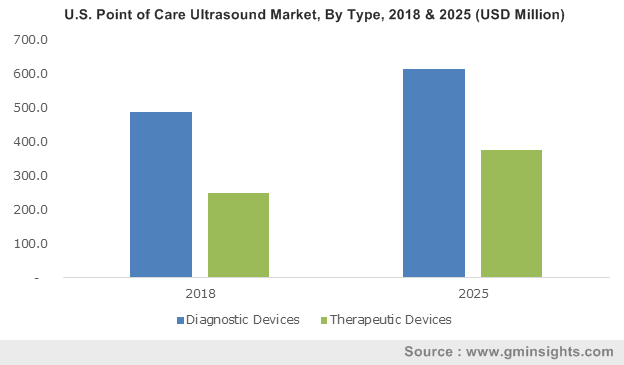Point of Care Ultrasound Market Price
3 prevalent trends influencing point of care ultrasound market size
Growing demand for fast and accurate diagnostic tools is expected to drive point of care ultrasound market growth in the ensuing years. Point-of-care ultrasound (POCUS) has become a standard tool in the emergency department, as it answers to specific clinical queries that narrow differentials, guide clinical therapy, and direct consultations and disposition.
U.S. Point of Care Ultrasound Market, By Type, 2018 & 2025 (USD Million)

Recent technological advancements have led to the development of miniature POCUS that range from stationary high-end systems to small sized devices that can easily be used to perform bedside tests as well as attain increased accuracy compared to traditional stethoscopes.
Rising elderly population, mostly prone to acute healthcare conditions like arthritis, heart disease, cancer, respiratory diseases and more, will help in augmenting point-of-care ultrasound industry size. For instance, reports from World Population Ageing 2017 cite that the total number of people aged above 80 across the globe will increase from 137 million to 425 million between 2017 and 2050.
Whereas, number of people aged over 60 are expected to be around 2.1 billion by 2050, slightly more compared to youth aged between 10-24 (2.0 billion) in the forecast timeline. These figures conclusively indicate a potential increase in demand for handheld and portable bedside diagnostic devices like POCUS in the aforementioned period.
The point-of-care ultrasound market to register growth with increased prevalence of cardiac arrests worldwide
Recently, the point-of-care ultrasound market size has registered immense inflation through the cardiology segment mainly due to the use of POCUS to determine the cause of cardiac arrest as well as for guiding resuscitation and interventions. The advent of smaller and more portable machines combined with improved picture quality has further increased product demand. POCUS has essentially helped patients with pulseless electrical activity (PEA) in revealing anatomic causes like cardiac tamponade, tension pneumothorax and pulmonary embolism.
Get a Sample Copy of this Report:@ https://www.gminsights.com/request-sample/detail/3325
Additionally, the sheer rise in cases of cardiac arrest across the globe is anticipated to amplify point of care ultrasound market size over the coming years. For instance, according to American Health Association’s Heart Disease and Stroke Statistics 2018, cardiovascular disease is said to be the main cause of death globally, accounting for over 17.9 million deaths in 2015 and is projected to grow to over 23.6 million by 2030.
With POCUS becoming a rather common diagnostic tool for cardiac resuscitation and helping in identifying anatomic causes for cardiac issues, POC ultrasound market will have much to gain from cardiology applications. Indeed, POC industry size from cardiology applications is slated to show a CAGR of 5.3% over 2019-2025.
Increased comfort and imaging accuracy for obstetrics patients to add to POCUS market size
Growing use of real-time imaging system in obstetrics & gynecology sector should favor POCUS industry growth. POCUS is touted to be a safer and more effective imaging modality that has rapidly expanded as a cost-saving, timesaving and lifesaving option in the pediatric emergency medicine (PEM) space.
Ultrasound has long been praised as an ideal imagining technology for detecting fetus development in expecting women. POCUS can also accelerate diagnosis and treatment of pediatric patients suffering from lower back pain, or ones who face difficulty bearing body weight, by evaluating the presence of a hip effusion.
Additionally POCUS helps to protect children from the risk of ionizing radiation unlike other imaging methods such as computed tomography (CT). According to the U.S. National Center for Biotechnology Information, it is estimated that from about 4 million pediatric CT scans performed in the U.S. annually, 4,870 patients are likely to be under risk of developing cancer in future. Lifesaving aids are expected to foster the point of care ultrasound market size over the coming years.
Medical tourism in Asia Pacific and its effects on point of care ultrasound industry size
Medical tourism is expected to play a significant role in the healthcare industry in the coming years. The easier affordability of healthcare services in many developing countries along with the presence of skilled professionals and world class facilities has added stimulus to the trend. India may be considered one of the best examples when it comes to evaluating the implication of such a trend on the point-of-care ultrasound market.
For instance, reports from UN’s Africa Renewal cite that, in 2015, about 40,000 Nigerians visited India of which half were reported to visit for myriad medical treatments that also include cardiovascular diseases. Such trends have helped the Asia Pacific point of care ultrasound market surpass $625 million in 2018.
It is anticipated that as hospitals and care providers are increasingly integrating point of care ultrasound into practice, diversification of applications and implementation will be exponential. With ultrasounds, physicians are ideally equipped to diagnose and manage patients more accurately and efficiently. Growing investments in the healthcare sector and rising R&D activities will thus help increase point of care ultrasound industry size, slated to cross USD 3 billion by 2025.
Author Name : Mateen Dalal
